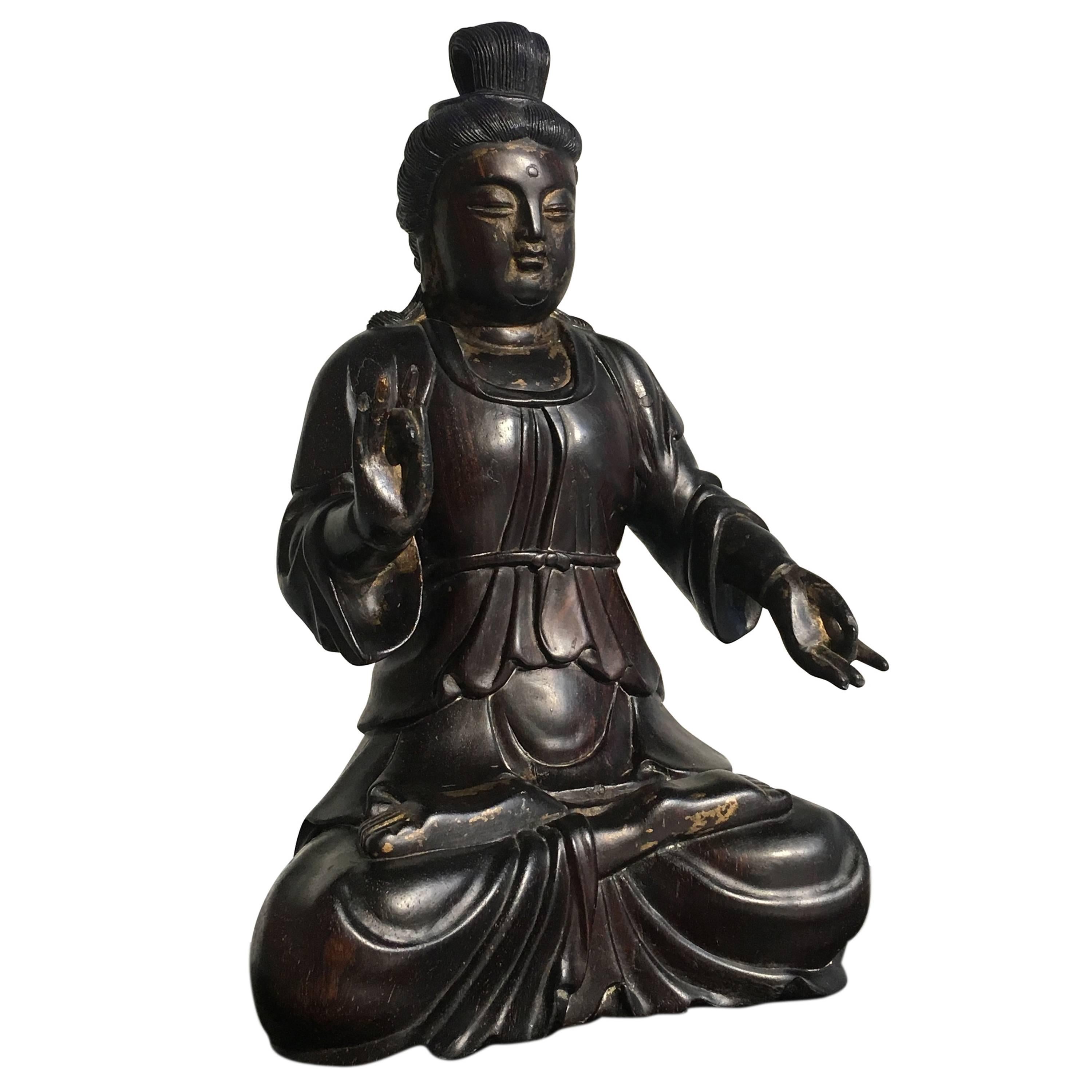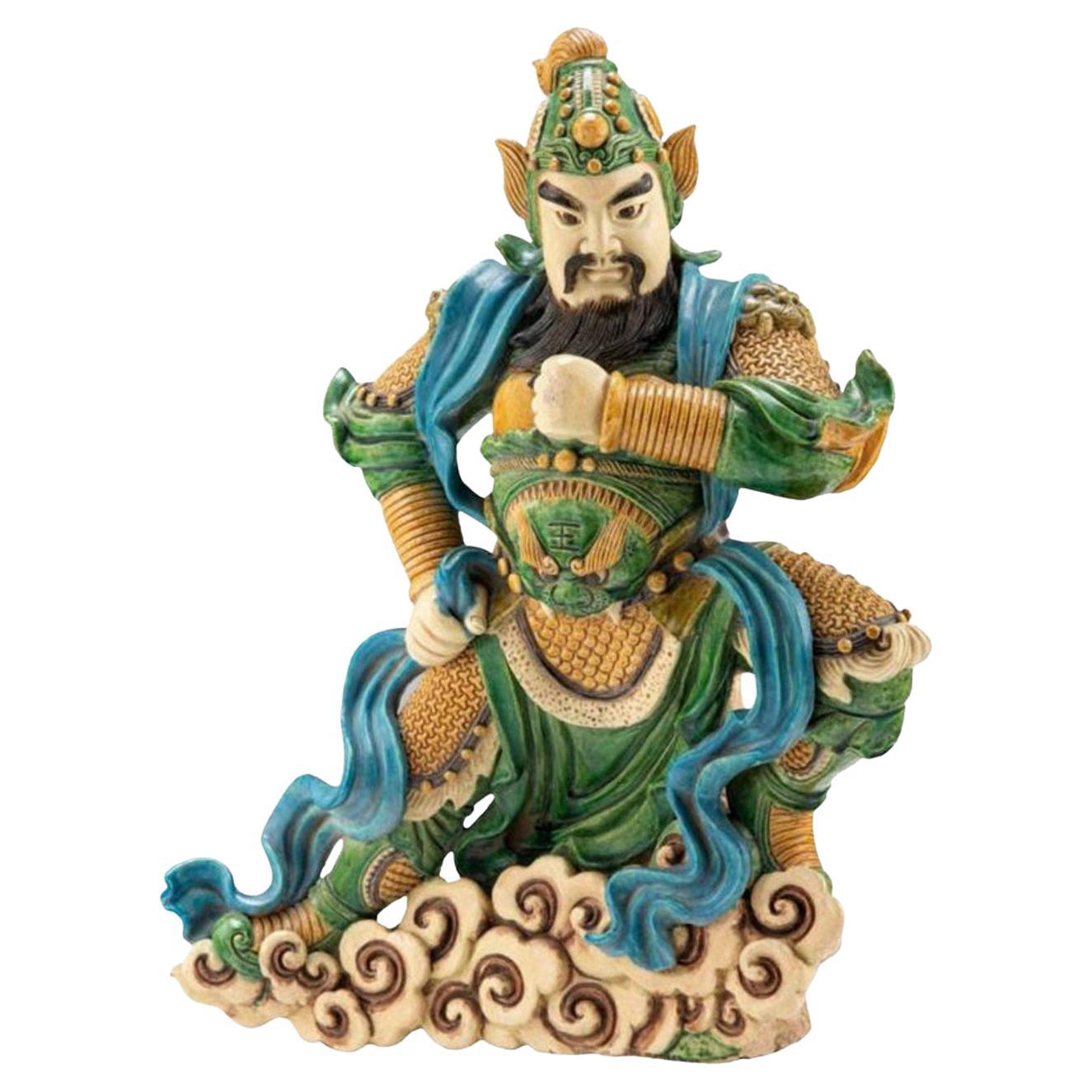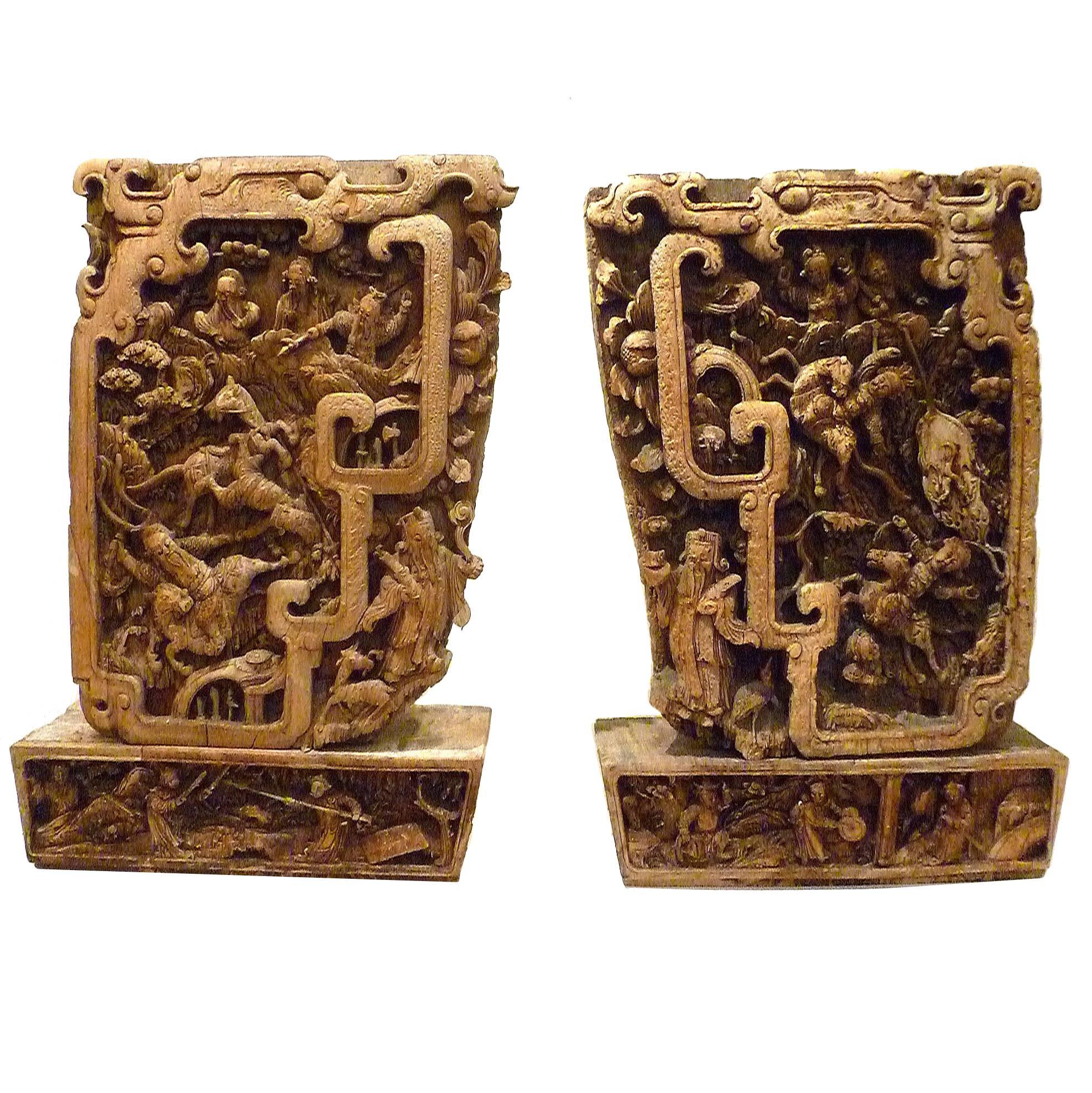Items Similar to Chinese 1900 Qing Dynasty Bodhisattva Altar Temple-Pagoda In Wood And Carvings
Want more images or videos?
Request additional images or videos from the seller
1 of 12
Chinese 1900 Qing Dynasty Bodhisattva Altar Temple-Pagoda In Wood And Carvings
About the Item
Buddhist altar temple-pagoda from the Qing Dynasty (1644-1911).
Fabulous and very rare, East Asian, Buddhist Altar Temple-Pagoda. It was created in China during the late Qing Dynasty to early Republic Period, circa late 19th to early 20th century. This is a beautiful, oversized and monumental carving of a Buddhist temple altar pagoda-house, made in a tall and rectangular form, that rest on rounded four-legs carved with demon's faces. In general is composed by two parts, with a superstructure of three-tiers carved to show on top, a seated Bodhisattva flanked-guarded by two others in different positions. Mounted at the sides, with a pair of scrolling detailed cantilever handles carved with dragons with the mythical pearl.
The sober temple bears four lengthy walls adorned with applique people, dragons, clouds, and birds surrounding a smaller pagoda, and the lower panels beneath it bear images of flowers and branch-dwelling birds.
The sloped curved roof part, is removable in one piece to discover a hidden rectangular compartment-box. It is lined with petite tiles design, with projecting three dimensional elements on each of the four corners, and a lining of openwork dragons along the topmost crest. A superb and magnificent antique piece!
This temple is one of the most beautiful and best realized that we have seen in our extensive research. The size is great, the quality of the carvings and the finishes are magnificent and in addition to all this, the degree of preservation is perfect with all its pieces and parts intact
Period: Late Qing dynasty (1644-1911).
Measures: 615 mm by 231 mm by 692 mm (24.2 x 9.10 x 27.25 Inches).
Techniques: Carved elements, individually assembled, woods base.
Weight: About 60 Pounds (27.21 Kg).
The Qing Dynasty
Officially the Great Qing, was the Manchu-led last dynasty in the imperial history of China. It was proclaimed in 1636 in Manchuria (modern-day Northeast China), in 1644 entered Beijing, extended its rule to cover all of China proper, and then extended the empire into Central Asia. The dynasty lasted until 1912. In orthodox Chinese historiography, the Qing dynasty was preceded by the Ming dynasty and succeeded by the Republic of China. The multiethnic Qing empire lasted for almost three centuries and assembled the territorial base for modern China. It was the largest Chinese dynasty and in 1790 the fourth largest empire in world history in terms of territorial size. With a population of 432 million in 1912, it was the world's most populous country at the time.
The Qing Dynasty Decorative Arts
Many craftsmen worked in the imperial court, producing artifacts for palace use: everything from items of jewelry art to beautiful Chinese lacquerware, including lacquered imperial thrones: see, for instance, the Qing Dynasty Imperial Throne (1775-80, Victoria and Albert Museum, London). The Imperial Household Department managed a number of crafts workshops both within the Forbidden City and outside it. Some of the skilled workers and master craftsmen were on permanent duty, like those in the imperial glass factory established in 1696 under the direction of the German Jesuit Kilian Stumpf (1655-1720). Other experts in gemstones carving, horn and jade sculpture and metallurgy were summoned to Beijing for a specific period of service.
Condition: The overall condition of this piece is excellent. Beside the little normal wear, there is no damage to any part. All elements are secured in the settings. This piece has been carefully inspected to guarantee the condition and authenticity.
INVENTORY REF: D070923ENNM/.1111
- Dimensions:Height: 27.25 in (69.22 cm)Width: 9.1 in (23.12 cm)Depth: 24.2 in (61.47 cm)
- Style:Qing (Of the Period)
- Materials and Techniques:
- Place of Origin:
- Period:
- Date of Manufacture:1890-1920
- Condition:Wear consistent with age and use. The overall condition of this piece is excellent. Beside the little normal wear, there is no damage to any part. All elements are secured in the settings. This piece has been carefully inspected to guarantee the condition and authenticity.
- Seller Location:Miami, FL
- Reference Number:
About the Seller
5.0
Platinum Seller
These expertly vetted sellers are 1stDibs' most experienced sellers and are rated highest by our customers.
1stDibs seller since 2023
63 sales on 1stDibs
Typical response time: <1 hour
- ShippingRetrieving quote...Ships From: Miami, FL
- Return PolicyA return for this item may be initiated within 1 day of delivery.
More From This SellerView All
- China 549-577 AD Northern Qi Dynasty Ancient Caparisoned Horse in EarthenwareLocated in Miami, FLExtremely rare Chinese pottery caparisoned horse from the Northern Qi region. A beautiful large sculptural piece, created in China during the Northern Qi dynasty period, between the 549 and 577 AD. This horse statue is extremely finely modeled of earthenware pottery, standing in a very elegant and majestic position striding on a trapezoidal shaped base. The animal has a gracefully arched neck to the left looking forward and its extremely well modeled. The head is adorned with a large detailed tassels of plumes and the body is embellished with a beautiful saddle and intricate harnesses. The trapping around the chest and rump is adorned with elaborated tassels and the straps are accented with multiples florets and bosses in high relief. Decorated with dotted and circles patterns. The surface is treated with applications of natural color pigments such; red, white and others. Has a measurements of 435 mm by 319 mm by 243 mm (17.10 x 12.55 x 9.55 Inches) (43.5 x 31.9 x 24.3 Cm). Northern Qi, was the successor state of the Chinese Xianbei state of Eastern Wei...Category
Antique 15th Century and Earlier Chinese Archaistic Antiquities
MaterialsEarthenware, Clay, Paint
- China 100 BC Han Dynasty Ancient Rare Stickman Sculpture in Earthenware PotteryLocated in Miami, FLStanding Stickman from the Han Dynasty. Original ancient Chinese tomb attendants sculpture of a tall, thin standing man wearing a short tunic. Beautifully crafted in grey earthenw...Category
Antique 15th Century and Earlier Chinese Han Antiquities
MaterialsIron
- China 549-577 AD Northern Qi Dynasty Ancient Caparisoned Horse In EarthenwareLocated in Miami, FLExceedingly rare Chinese pottery caparisoned horse from the Northern Qi region. A beautiful sculptural piece, created in China during the Northern Qi dynasty period, between the 549 and 577 AD. This horse statue is extremely finely modeled of earthenware pottery, standing in a very elegant and majestic position striding on a trapezoidal shaped base. The animal has a gracefully arched neck to the left and its extremely well modeled. The head is adorned with a large detailed tassels of plumes and the body is embellished with a beautiful saddle and intricate harnesses. The trapping around the chest and rump is adorned with elaborated tassels and the straps are accented with multiples florets and bosses in high relief. The surface is treated with applications of natural pigments such; red, white and others. Has a measurements of 394 mm by 343 mm by 257 mm (15.53 x 13.52 x 10.15 Inches) (39.4 x 34.3 x 25.7 Cm). Northern Qi, was the successor state of the Chinese Xianbei state of Eastern Wei...Category
Antique 15th Century and Earlier Chinese Archaistic Sculptures and Carvings
MaterialsEarthenware, Pottery
- Japan Meiji 1900 Three Bronze Ducks Sculpture in Wood Stand and CoralLocated in Miami, FLSculptural composition of the ducks from the Japanese Meiji Period. Beautiful and very well realized sculptural composition of three ducks, made during the japanese imperial perio...Category
Antique Early 1900s Japanese Meiji Sculptures and Carvings
MaterialsCoral, Bronze
- Japan 1890 Meiji Period Ebisu Sculpture in Wood Carving of an Old FishermanLocated in Miami, FLAn extremely well detailed wood carving of Ebisu, as a fisherman. Beautiful and well detailed sculpture, created in Japan during the Meiji dynastic period (1868-1912) back in the 1890's. This piece represent the god of good fortune Ebisu. Was exceptionally carved and executed from one solid single piece of rose wood, showing a gorgeous face expression, with intricate details in the hands and feets, he's carrying as usual a rod and a fish. Ebisu (yebisu), ???, god of fortune, the ocean and fisherman. In the japanese mythology is one of the seven gods of luck, sichi-fuku-jin, the patron of the fisherman and tradesmen. he is depicted as a bearded, smiling fisherman with formal long court ropes, often carrying a rod in one hand and a tai, symbolic fish of the good luck, in the other. The height is 14.25 inches (36.20 cm) and the base measurements is 6.5 by 6.45 inches (16.5 x 16.38 cm). Meiji period, is an era of Japanese history that extended from October 23, 1868 to July 30, 1912.The Meiji era was the first half of the Empire of Japan, when the Japanese people moved from being an isolated feudal society at risk of colonization by Western powers to the new paradigm of a modern, industrialized nation state and emergent great power, influenced by Western scientific, technological, philosophical, political, legal, and aesthetic ideas. As a result of such wholesale adoption of radically different ideas, the changes to Japan were profound, and affected its social structure, internal politics, economy, military, and foreign...Category
Antique 1890s Japanese Meiji Sculptures and Carvings
MaterialsWood
- China 618-907 AD Tang Dynasty Pair Of Polychromate Earth Spirits ZhenmushouLocated in Miami, FLPair of Earths Spirits "Zhenmushou" from the China Tang Dynasty 618-907 AD. A beautiful and rare pair of "Earths Spirits guardians" from the Yunnan province region in the ancient China. This was created in clay earthenware pottery during the Tang Dynasty period between 618 and 907 AD. Featuring the molded figures of two seated guardians with decorations with polychrome pigmentations. The figures are seated on their haunches with cloven hooves planted firmly on the base looking forward with their front legs in a straight position. Both with face and body alert expressions on a rectangular base. Earth spirits usually appear in pairs, one with a human head and the other with a lion head. Their supernatural powers, indicated by antlers, spiky flanges and flames, enable them to confront evil spirits and protect any precincts within their gaze. Have been believed to protect the living by keeping the spirits of the dead from inappropriately roaming the world outside the tomb. Zhenmushou or guardian deities, developed from a line of protective spirits found normally in pairs at the front of Tang dynasty tombs. They served both to protect the figure from untoward spirits, and the outside world from the roving spirit of the dead. Combining features from a number of animals to form the perfect mythic beast, these mythical creatures were perceived to be the ideal guardians of the dead The semi human faced figure has a measures of 11.25 by 4.5 by 5.75 inches (28.57 x 11.43 x 14.60 Cm). The mythological lion animal figure has a measures of 10 by 5 by 5.8 inches (24.5 x 12.7 x 14.73 Cm). Tang dynasty or Tang Empire, was an imperial dynasty of China that ruled from 618 to 907, with an interregnum between 690 and 705. It was preceded by the Sui dynasty and followed by the Five Dynasties and Tend Kingdoms period. Historians generally regard the Tang as a high point in Chinese civilization, and a the golden age of cosmopolitan culture. Tang territory, acquired through the military campaigns of its early rulers, rivaled that of the Han dynasty. The Li family founded the dynasty, seizing power during the decline and collapse of the Sui Empire and inaugurating a period of progress and stability in the first half of the dynasty's rule. The dynasty was formally interrupted during 690–705 when Empress Wu Zetian seized the throne, proclaiming the Wu Zhou dynasty...Category
Antique 15th Century and Earlier Chinese Tang Antiquities
MaterialsEarthenware, Pottery
You May Also Like
- Chinese Carved Zitan Figure of a Bodhisattva, Qing DynastyLocated in Austin, TXA finely carved Chinese zitan wood figure of an unidentified bodhisattva, possibly Guanyin, late Qing Dynasty, circa 1900, China. The androgynous figure has a plump, almost matronly face, with downcast eyes and a gentle smile. The hair in long tresses, gathered and tied in a high chignon. The enlightened being is portrayed seated in dhyanasana, bare feet resting on crossed legs, both soles pointing up. Thick robes billow and drape around the full figured body. The hands display...Category
Early 20th Century Chinese Qing Sculptures and Carvings
MaterialsLapis Lazuli
- Qing Dynasty Chinese Sancai Temple Guardian FigureLocated in Forney, TXA large antique Chinese glazed Sancai pottery temple guardian figure, designed to ward off evil spirits and protect the owners tumb. Hand crafted, excep...Category
Antique 18th Century Sculptures and Carvings
MaterialsPottery
- Lady Guanyin Bodhisattva Gilded Wood Carving - Ming Dynasty, China 1368-1644 ADLocated in San Pedro Garza Garcia, Nuevo LeonMagnificent Lady Guanyin Bodhisattva seated in Royal Relaxation pose hand-carved in Gilded Wood with traces of paint still visible. This expressi...Category
Antique 15th Century and Earlier Chinese Ming Antiquities
MaterialsWood
- Antique Chinese Celadon Green Jade Carving, Triple Vase, Qing DynastyLocated in New York, NYAn extremely finely carved antique Chinese Qing dynasty, Celadon green triple vase/brush washer with an Imperial Dragon from behind attacking a bird in fro...Category
Antique 19th Century Chinese Qing Scholar's Objects
MaterialsJade
- Pair of Chinese Qing Dynasty Openwork Wall Hanging Giltwood CarvingsLocated in Vero Beach, FLAntique pair of Chinese 18th century Qing dynasty openwork wood carving Gilded screen work wall hanging architectural elements. This pair of Chinese pan...Category
Antique 19th Century Chinese Qing Architectural Elements
MaterialsGiltwood
- Pair of Qing Dynasty Architecture Carving PanelsLocated in Greenwich, CTPair of Qing dynasty architecture carving panels, detail carvings with warriors riding horses.Category
Antique 19th Century Chinese Qing Sculptures and Carvings
MaterialsWood
Recently Viewed
View AllMore Ways To Browse
Wood Carving Pair
The Forbidden City
Carved Bird Box
Ming House
Wall Mount Crest
Jade Box Antique
Jade Dragon Carving
Roof Cresting
Antique Lacquered Chinese Boxes
Hand Carved Wood Dragon
Antique Chinese Sculpture Pagoda
Qing Dynasty Lacquer Jewelry Box
Antique Chinese Roof Tiles
Antique Chinese Wood Jewelry Box
Orthodox Altar
Used Fine China
Used Asian Sculptures
Old Chinese





